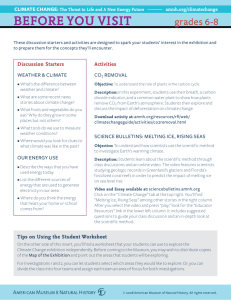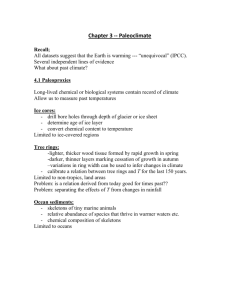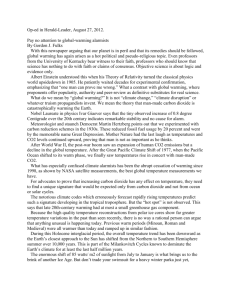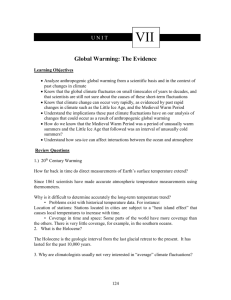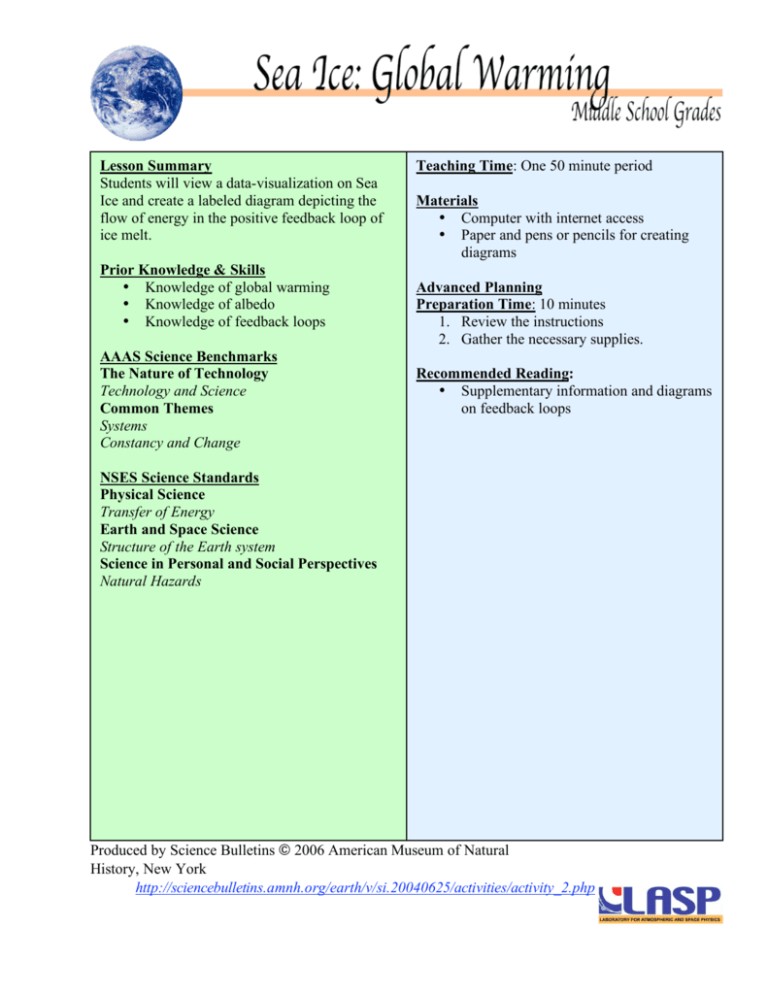
Lesson Summary
Students will view a data-visualization on Sea
Ice and create a labeled diagram depicting the
flow of energy in the positive feedback loop of
ice melt.
Prior Knowledge & Skills
• Knowledge of global warming
• Knowledge of albedo
• Knowledge of feedback loops
AAAS Science Benchmarks
The Nature of Technology
Technology and Science
Common Themes
Systems
Constancy and Change
Teaching Time: One 50 minute period
Materials
• Computer with internet access
• Paper and pens or pencils for creating
diagrams
Advanced Planning
Preparation Time: 10 minutes
1. Review the instructions
2. Gather the necessary supplies.
Recommended Reading:
• Supplementary information and diagrams
on feedback loops
NSES Science Standards
Physical Science
Transfer of Energy
Earth and Space Science
Structure of the Earth system
Science in Personal and Social Perspectives
Natural Hazards
Produced by Science Bulletins © 2006 American Museum of Natural
History, New York
http://sciencebulletins.amnh.org/earth/v/si.20040625/activities/activity_2.php
Earth Activity
Learning Activity: Sea Ice: Global Warming
Print This Page
Sea Ice
http://sciencebulletins.amnh.org/earth/v/si.20040625/index.php
Purpose:
Have students watch the sea ice data visualization at the website listed above After viewing the data
visualization on sea ice,
and read the accompanying information. Discuss the cycle of freezing and
thawing sea ice in the Arctic. Use the following questions to guide a discussion: students will discuss what
impact the event has on global
warming. Students will create a
● What do you know about the geography of the Arctic? (A frozen sea
diagram illustrating the positive
surrounded by land)
feedback loop.
● What does this data visualization show? (The cycle of thawing and
freezing sea ice over a 10-year period)
Suitable For:
● The visualization shows the thawing and freezing of sea ice from
Entire class
1993 to the present. Do you notice any significant changes in the
●
●
●
●
pattern of freezing and thawing over the 10-year period?
What does the visualization say about the pattern of freezing and
thawing over the last three decades? (The amount of sea ice has
been dwindling)
The science behind global warming is very complex and highly
debated in the scientific community. How does the data about the
thawing and freezing of sea ice in the Arctic support the global
warming theory? (For more information about global warming, go to:
What Causes Climate and Climate Change? Ice Ages, at
http://learn.amnh.org/courses/earth_resource4.php)
How does the positive feedback loop cycle created by dwindling sea
ice contribute to the warming trend in the Arctic? (If necessary direct
students to the second paragraph in the data visualization which
reads: "Over the past few decades, the amount of sea ice in the
Arctic has gradually been dwindling. While the white Arctic ice
reflects the Sun’s rays back into the upper atmosphere, the
surrounding water absorbs heat and increases in temperature. The
warmer water continues to melt more ice, decreasing the amount of
solar energy that can be reflected and increasing the energy
absorbed by the water. This effect, called a positive feedback loop,
contributes to a trend towards warmer global temperatures.")
Have students work with a partner. Have the description of the
positive feedback loop available for students to refer to. Call on
partners to create and label a diagram showing the flow of energy
through the positive feedback loop.
http://sciencebulletins.amnh.org/earth/v/si.20040625/activities/activity_2.php (1 of 2) [7/27/07 9:14:21 AM]
Time:
One class period
Earth Activity
Call on volunteers to share their diagrams with the class and explain the flow
of energy through the positive feedback loop. Ask students to consider what
might be some of the far-reaching effects of the global warming trend.
Invite volunteers to further investigate the topic of global warming. Have
them prepare a presentation of their findings and share their findings with
the rest of the class.
Review global warming and the positive feedback loop with students. Ask
them to debate this question: Is the reduction of sea ice in the Arctic region a
cause or a result of the positive feedback loop?
Invite students who are interested to continue to investigate the topic of sea
ice. Suggest they visit the Web sites listed on the data visualization Web
page as well as looking for news articles on the topic. Students could be
asked to update the class when new information becomes available.
©2004 American Museum of Natural History. All Rights Reserved.
http://www.amnh.org
http://sciencebulletins.amnh.org/earth/v/si.20040625/activities/activity_2.php (2 of 2) [7/27/07 9:14:21 AM]
Science Bulletins
http://sciencebulletins.amnh.org



